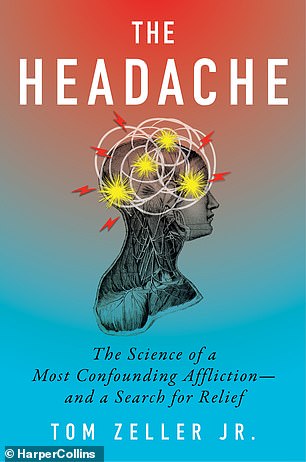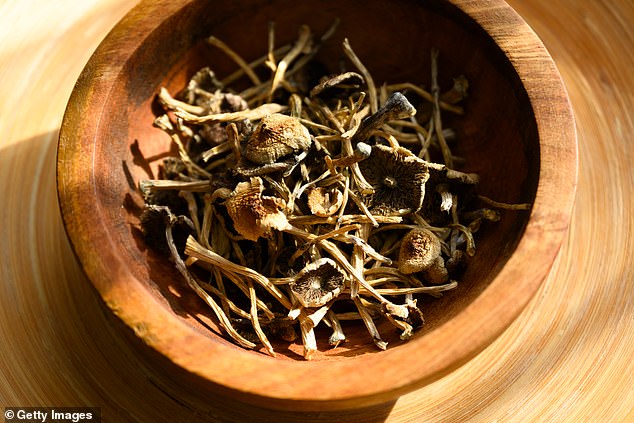Tom Zeller Jr has done just about anything to get rid of his headaches.
He’s chugged 60 glasses of water in a day, inhaled oxygen straight from the tank and even tripped on magic mushrooms on top of the western Montana mountains.
The 56–year–old science journalist was diagnosed about three decades ago with cluster headaches, debilitating headaches that strike randomly and drag out for weeks or months at a time.
While it could be years between attacks, they return as fast as a lightning strike, with Zeller likening them to resting your hand on a hot burner and not being able to take it off.
Zeller told DailyMail.com: ‘They’re excruciatingly painful. The tend to come on really, really quickly, within a matter of seconds. You don’t usually have a warning and they will knock you down to the floor until they’re over.’
Zeller, who lives in Montana, spent much of his adult life suffering attacks up to four times a day for months at a time until they suddenly disappeared.
His clusters have slowed in recent years, but like the 1 in 1,000 Americans with the disorder, Zeller waits for the next attack with limited tools at his disposal.
In his newly released book, The Headache: The Science of a Most Confounding Affliction – and a Search for Relief, Zeller detailed his decades–long search for cluster headache relief, along with the wackiest things he’s tried to quell the pain.

Journalist Tom Zeller Jr’s new book explores treatments and causes of cluster headaches
‘I never wanted to write this book, to be honest. I did not want people to know I had headaches. It’s just terrible to be seen in this way,’ Zeller told DailyMail.com.
‘But I also felt like if you’re going to write a book, they say, “Write about what you know.” I realized that I know headaches.’
Cluster headaches are extremely painful and strike quickly in frequent attacks, or ‘clusters,’ lasting weeks or months at a time, earning the grim nickname ‘suicide headaches.’
The disorder usually causes sharp and stabbing pain in or around the eye, restlessness, tears and eye redness, forehead sweating, swelling around the eye and eyelid drooping.
While a close relative of migraines, they’re far less common. About 0.1 percent of Americans have had a cluster headache attack at some point in their lives, while 15 percent – most of whom are women – have migraines.
For Zeller, the attacks drove a wedge in his journalism career, often forcing him to ‘retreat from opportunities in the newsroom.’
‘It’s not easy. The book talks about how any sort of headache disorder is kind of a drag on the momentum of your life. They’re always slowing you down,’ he said.
‘When I wasn’t having the headaches, I felt like I was pretty bold and pretty accomplished as a journalist. But when the headaches would come on, I would sort of disappear and I would work from home a lot.

Cluster headaches affect one in 1,000 Americans and cause debilitating pain (stock image)
‘There’s a lot of stigma attached to headaches in a weird way. I tried very hard to make sure that no one knew that I had these headaches. You start to hide and that meant hiding from opportunities at work too.’
Throughout the book, Zeller detailed a laundry list of unorthodox treatments he tried or researched.
‘I was being ground down by the relentless injections, self–administered into an abdomen bruised and pockmarked by previous jabs, and overuse of the medication was likely driving an endless cycle of rebound attacks,’ he wrote in his book.
‘Given this unappealing tableau, why not shrooms?’
Psilocybin, the active compound in magic mushrooms, has been shown to alter how the brain processes and perceives pain signals and is thought to reduce inflammation.
He’s also tried inhaling capsaicin, an extract in chili peppers that gives them their signature heat. Some research suggests it helps desensitize nerve fibers in the nasal passages that transmit cluster headache pain to the brain.
Zeller also rented oxygen tanks from a welding supplier as a ‘really fast way to abort a cluster headache attack.’
‘I also remember a forum saying that if you just tried to chug like 60 glasses of water a day, or some absurd amount, it would cure your headaches. I was willing to try, but all I did was visit the toilet a lot with headaches,’ he recalled.
Zeller said many patients with cluster headaches have to rely on bizarre hacks because of the lack of medications geared specifically toward their condition.

Pictured is the cover of Tom Zeller Jr’s book
‘The thing that surprised me most, and what probably prompted the book, was that so little research was out there on primary headache disorders,’ Zeller explained.
Patients are often prescribed beta blockers, antipsychotics, antidepressants and other drugs manufactured for other illnesses, as they can treat headaches in some people.
Recently, the advent of CGRP drugs has changed the picture. Approved by the FDA in 2018, these preventative drugs block or reduce the effects of CGRP, which causes migraine and cluster headache pain.
‘A lot of times you’ll find a drug or remedy that does kind of work, but the body adapts. We’re very plastic, and over time, those things start to wane,’ Zeller said.
Zeller uses the CGRP medication Emgality, the only FDA approved medication specifically designed for cluster headaches and migraines.
The cluster headache dose of Emgality is significantly higher than the migraine dose – 300 milligrams compared to 120 milligrams – and both versions are given through a subcutaneous injection just under the skin.
‘Cluster headaches are their own unique animal, so once the headaches start happening, it does seem to be pretty hard to stop,’ Zeller revealed.
‘But I think three times in I’m sort of convinced that the CGRP blockers work for me to stop a bout from happening.’

The book opens with him tripping on magic mushrooms for cluster headaches (stock image)
Like migraines, cluster headaches often become less frequent and severe with age, which some research suggests could be due to hormonal fluctuations and altered blood vessel function in the brain.
Zeller’s clusters in recent years have slowed and can now fall years apart, but he’s far from being in remission.
‘I don’t think I, or anyone really, is out of the woods yet,’ he said.
For now, Zeller said he hopes his new book will help improve cluster headache awareness and provide a sense of community for readers with the condition.
In his research, he spoke with several cluster headache and migraine patients who at first were ‘guarded’ and wary of speaking about their experience over fears of it being trivialized.
But throughout the interviews, they became excited because they had ‘this pent–up desire to just unload about it.’
‘I hope they feel seen by the book,’ Zeller said.
‘Someone out there is paying attention and you can take heart in that, and if you’re able to buy time between painful bouts, I hope that you know the book will be affirming in that you know you’re not alone.’
The Headache: The Science of a Most Confounding Affliction – and a Search for Relief is available on Amazon, Barnes & Noble, Target and others.












